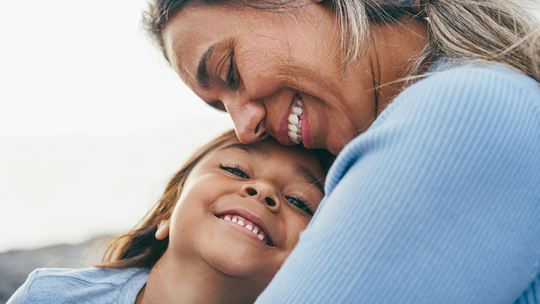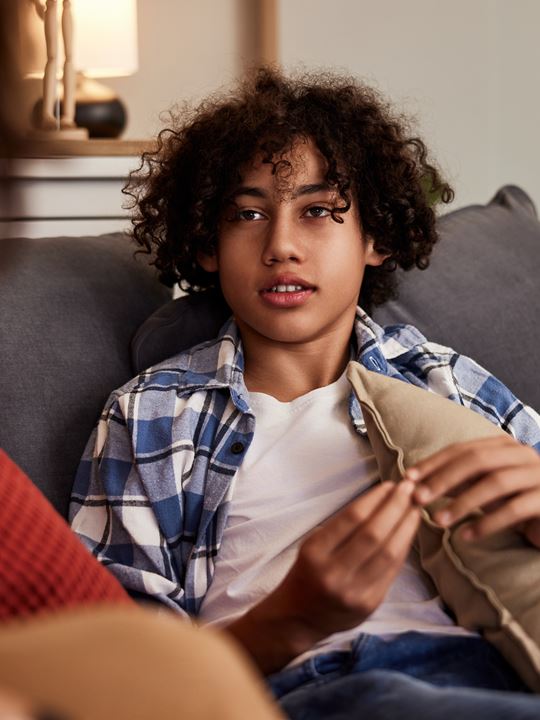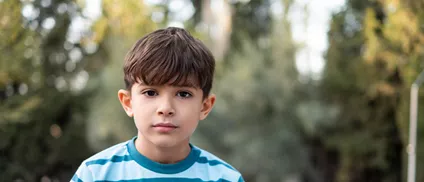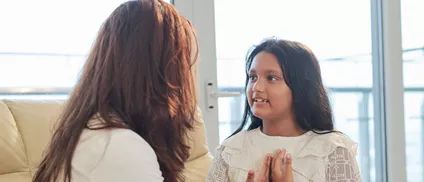
Childhood trauma and attachment
Explore how a child’s relationship with primary caregivers and those crucial early interactions can shape their attachment style.
Many children in care have developed self-protective strategies that have helped them survive abuse and neglect.
These strategies can significantly influence how they navigate new relationships and form attachments, impacting all areas of life.
However, with a loving home and therapeutic parenting, we can help children feel safe enough to let go of their strategies so they can build secure attachments and have a brighter future.
In this article, you’ll learn:
What is attachment?
Attachments (or ‘relationships’) are the bonds we form with others from birth, starting with our primary caregiver. They are fundamental to survival because they provide us with physical and emotional protection and safety when we are at our most vulnerable.
These relationships help us understand the world, answering questions like, who is safe, what do I need to do to have my needs met, and who can I rely on? These initial relationships are crucial to child development.
They can offer reassurance, stability and a secure base to explore the world. Alternatively, they can be unpredictable, abusive or neglectful, so children have no choice but to adapt their behaviour to their environment to survive.

Secure v Insecure Attachment
Attachments can be secure or insecure depending on the relationship a child has with their primary caregiver.
Secure Attachment
A secure attachment forms when the care children receive from their primary caregiver is reliable and meets their physical and emotional needs. Children with a secure attachment may show distress when separated from their primary caregiver but are easily soothed by their presence and comfort when they return.
A secure attachment makes children feel safe and loved, nurturing their curiosity so they can explore the world. It assures children that they have a place of safety they can return to if things get a bit scary or they need encouragement.
Children with a secure attachment tend to have better outcomes because they haven’t had to live in a survival state, adapting their behaviour to avoid danger. Now and in the future, this can help them:
- Form healthy and enduring relationships with friends and romantic partners
- Perform better at school, giving them opportunities to achieve
- Have higher self-esteem and a positive self-image
- Be more resilient to stress, aiding positive mental well-being
- Trust others and ask for help rather than going it alone
- Have more confidence to ask questions and explore the world
- Understand their likes and dislikes
- Regulate their emotions and find solutions to resolve conflict
- Find it easier to adapt to change.
Insecure Attachment
When children receive inconsistent, neglectful or abusive care from their primary caregiver, they may form an insecure attachment.
They may feel unsafe because they can’t rely on their primary caregiver to take care of their emotional and physical well-being. They may feel less able to explore the world because they don’t have a refuge to return to for comfort or support.
Three Styles of Insecure Attachment
John Bowlby and Mary Ainsworth identified several styles of insecure attachment in the 1950s, which have been extensively studied and expanded upon in the models of attachment we use today.
They identified three primary styles of insecure attachment:
Ambivalent
A child may be wary of strangers and nervous when meeting new people. When they are young, they may show distress when separated from their caregiver and struggle to be consoled when they reunite. It may be summarised as children showing mixed feelings about the confidence they can have in their relationship with a primary caregiver.
Children described as having an insecure-ambivalent attachment style, now and in the future, may:
- Struggle to trust others, affecting their ability to form relationships
- Constantly seek reassurance or become clingy
- Need to be the centre of attention
- Not have developed emotional regulation skills
- Seek comfort from another adult, such as a teacher
- Experience an acute fear of rejection or abandonment
- Experience poor mental health
- Find change challenging and unsettling
- Look at the world as a scary place
Avoidant
A child may avoid their caregiver and rely on themselves to self-soothe. As a young child, they may become upset when separated from their caregiver, but when reunited, they may appear to reject any comfort offered.
Children described as having an insecure-avoidant attachment style, now and in the future, may:
- Prefer their own company
- Keep their emotions locked away
- Experience an acute fear of rejection or abandonment
- Have trouble forming relationships to avoid being vulnerable
- Keep relationships on a surface level and at arm’s length
- Avoid asking for help and appear independent
- Look at the world negatively
- Have low self-esteem
- Experience poor mental health
Disorganised
This attachment style was added later for those children who did not easily fit into the ambivalent or avoidant categories. Instead, they may have flitted between the two styles, conveying mixed emotions. For example, they may display intense fear of their caregivers alongside craving their attention. When young, they may be upset when separated from their caregiver, but when reunited, they show fear or hide.
Children described as having an insecure-disorganised attachment style often have a combination of insecure-avoidant and insecure-ambivalent attachment styles, shifting from one style to the other.
Now and in the future, they may:
- Pursue connections but also push people away
- Ask for help but then reject it when offered
- Switch between repressing their emotions and having big emotional reactions
- Be self-reliant and independent but also need frequent reassurance
How are attachment styles developed?
Attachment styles develop through a child’s relationship with their primary caregiver. Insecure attachment styles are born out of the self-protecting strategies children develop to survive inconsistent, abusive or neglectful relationships with their primary caregiver.
For example, if a child has experienced neglect, they may have had to cry a little louder to have their needs met. They have learned that the only way to stay connected to their caregivers is by staying close to them and amplifying their distress, characteristics of an insecure-ambivalent attachment style. If they don’t feel confident they are at the forefront of their caregivers’ thoughts, feelings and actions, they may fear neglect of their needs and require constant reassurance to feel secure.
If a child has experienced abuse, they may have learned that staying quiet and withdrawing from their caregiver is the best way to avoid harm. In their environment, they may have had no choice but to stifle their emotions and rely on themselves for comfort to stay safe, characteristics of an insecure-avoidant attachment style.
Self-protecting strategies for children in care
Many children in care have experienced prolonged abuse or neglect, so they have had to form self-protecting strategies to survive in their environment. These survival strategies underpin their patterns of being and relating, which can impact all areas of their life.
Some children will suppress their feelings because, in the past, sharing them has been futile or made them unsafe. When they move into foster care, they may:
- Idolise their birth family with the belief that those who hurt them will save them
- Struggle to find emotions for those who caused their trauma
- Be people-pleasers, adapting their behaviour to suit what they believe the people they are around want
- Distance themselves from others, avoiding connection to protect themselves from harm
- Reject care but provide care for others because being in control is safer than being vulnerable
Other children will suppress their thinking and increase their emotional response because, in their birth home, this was the only way to get their needs met. When they move into foster care, they may:
- Exaggerate or amplify their distress, which evokes strong emotions in the adults around them
- Seem unable to think about the impact their actions may have
- Find it difficult to see other people’s perspectives
- Rely heavily on their feelings to analyse situations
- Be anxious and clingy
- Rely on constant reassurance to feel safe
- Deliberately hurt themselves to cope with distress, and/or elicit caregiving intervention
- Find comfort in teachers and older children.

Helping children move forward
When children move into foster care, they are very likely to continue to use their self-protecting strategies for some time. This is because these strategies develop unconsciously during a period of rapid brain development and offer a sense of safety.
However, with a loving home and therapeutic foster care, we can gradually help children feel safe enough to experiment with new ways of being. They can then call on new strategies, better adapted to their new circumstances and relationships.
Therapeutic relationships provide a foundation for change
Helping children move forward starts with a nurturing home where their emotional and physical needs are consistently met. This provides a platform for therapeutic foster care where we look beyond behaviour, understanding that the strategies they use have helped them survive difficult experiences.
When children use their survival strategies in the foster home, their behaviour may seem unconventional, disruptive or simply not ok. However, when you acknowledge the reason for a child’s behaviour and consider their fears and hopes, you can offer the right support. In time, the child will learn that although their survival strategies got them to where they are, they are no longer needed because they’re in a safe and more secure relationship.
Attachment styles are not set in stone
In fact, like all of us, children and young people constantly evolve with every tiny interaction they have with the important people around them. The emotional connection, understanding and sense of belonging you can offer as a foster parent is the foundation for a brighter future.
While it’s not an easy journey, children and young people need your support and encouragement to feel safe enough to let go of the strategies that have helped them survive up to this point and to gain the confidence to try new ones. It is absolutely possible to make little steps toward a better tomorrow as they begin to heal from their trauma.
Learn about trauma…

The impact of trauma
Discover the impact of early childhood trauma, and what it means for young people in foster care.

Trauma and the brain
Learn about the profound impact that childhood trauma can have on brain development.

Healing from trauma
Explore the strategies and therapeutic perspectives you need to help children recover from trauma.
